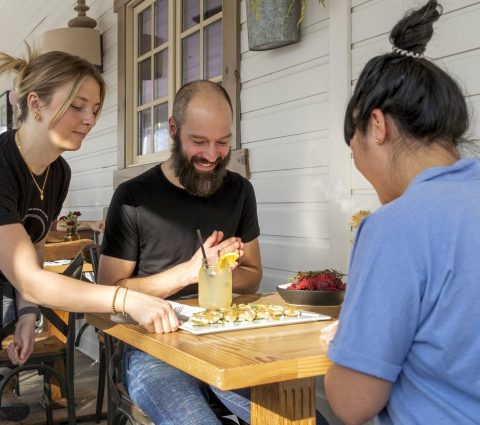- Things To Do
- Events
- Food & Drink
-
Places To Go
- Winnipeg
- Churchill
- Eastern Region
- Central Region
- Interlake Region
- Parkland Region
- Western Region
- Manitoba North
- Must-See Destinations
-
Itineraries
- Island Getaway on the Prairies
- Wheat City Wanderings in Brandon
- Escape to the water and the wild
- St. Boniface Winter: Passion and History
- Follow the path to a story in Neepawa
- Unleash your inner Viking this winter
- Explore Clear Lake this winter like never before
- Breathe in the Whiteshell this winter
- Go North for a boreal forest escape
- Treaty Areas
- Where To Stay
- Trip Essentials
- #ExploreMB Blog
Navigation Options
- FREN
- Things To Do
- Events
- Food & Drink
-
Places To Go
- Winnipeg
- Churchill
- Eastern Region
- Central Region
- Interlake Region
- Parkland Region
- Western Region
- Manitoba North
- Must-See Destinations
-
Itineraries
- Island Getaway on the Prairies
- Wheat City Wanderings in Brandon
- Escape to the water and the wild
- St. Boniface Winter: Passion and History
- Follow the path to a story in Neepawa
- Unleash your inner Viking this winter
- Explore Clear Lake this winter like never before
- Breathe in the Whiteshell this winter
- Go North for a boreal forest escape
- Treaty Areas
- Where To Stay
- Trip Essentials
- #ExploreMB Blog
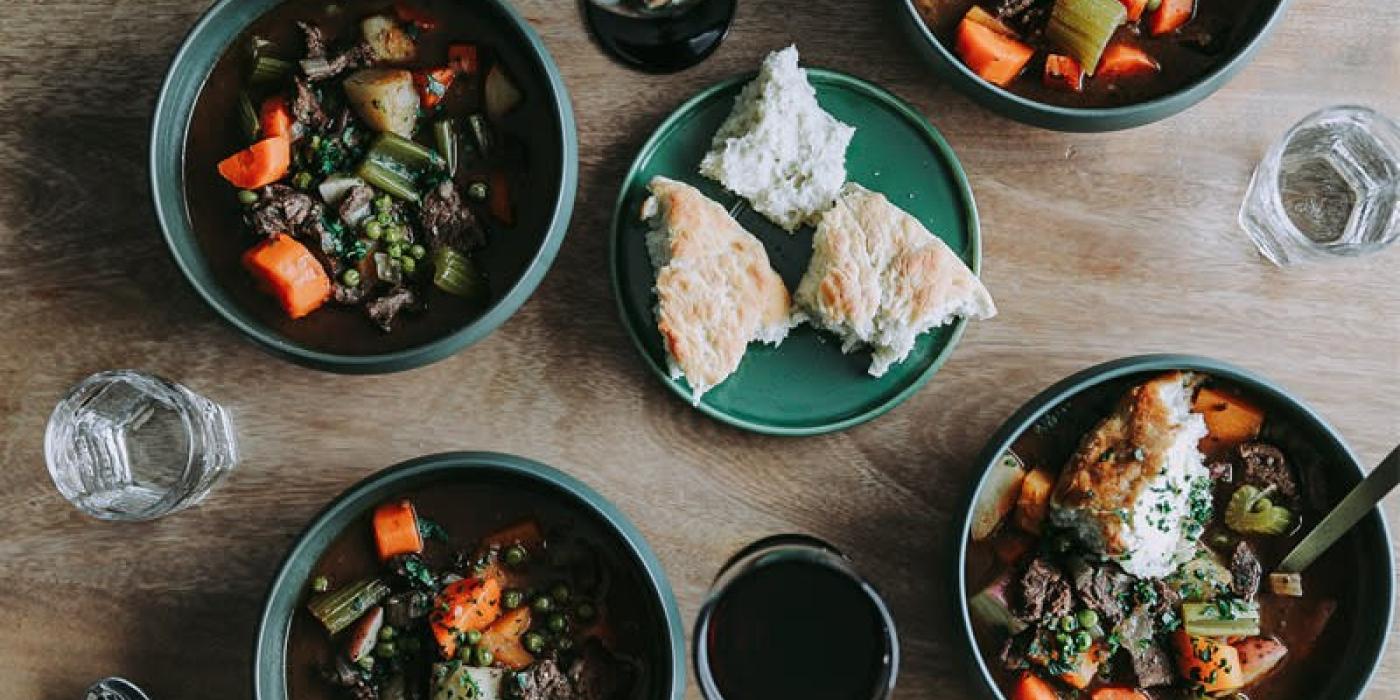
Eat like a Manitoban: Hearty Moose Stew with Winter Root Vegetables and Bannock Recipe
Posted March 10, 2020 | Author Kirsten Buck
Growing up in a Cree family, one of the first words you learn is michiso, which means eat! I spent most of my early childhood with my mom’s side of the family, the Garson’s, in Split Lake Manitoba - or Tataskweyak Cree Nation. Split Lake is a small Indigenous community that sits between Thompson and Gillam, over 900 km northeast of Winnipeg. As kids, we were always encouraged to go outside and play with our cousins and friends - from the time we woke up, until it got dark. We played in the bush, rode our bikes, made secret forts, picked berries, and sometimes we even got to go fishing down by the lake. Whether this was to get us into nature, or maybe just to get us out of the house, it really made for some great childhood memories.
My cho-chum (grandpa), Noah Garson, didn’t speak English. He would speak to us in Cree, and somehow we always knew was he was trying to communicate despite us kids not knowing the language very well. I’ll never forget the kindness of his eyes, his contagious laugh, and his big friendly smile. My grandpa was an avid hunter and trapper. It’s how he earned a living, how he always took care of his family, and he was great at it. He would go hunting for months at a time, usually by himself, and come back with pelts to sell at auction, fresh fish, wild Labrador tea, and moose meat that would feed everyone. He loved nothing more than being in the bush and called it “his heaven”. I had only been there once while supplies were being dropped off by plane and understood why he loved it. It was untouched wild earth. Truly serene, peaceful and quiet.
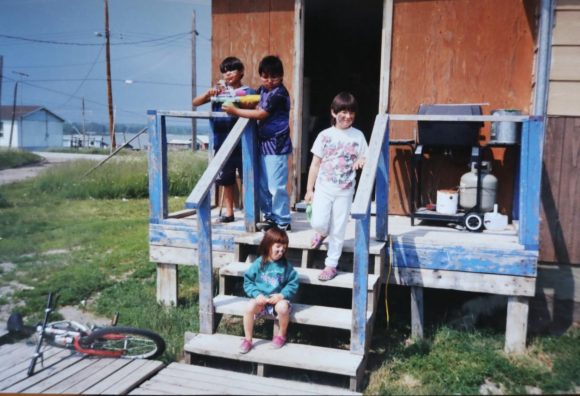
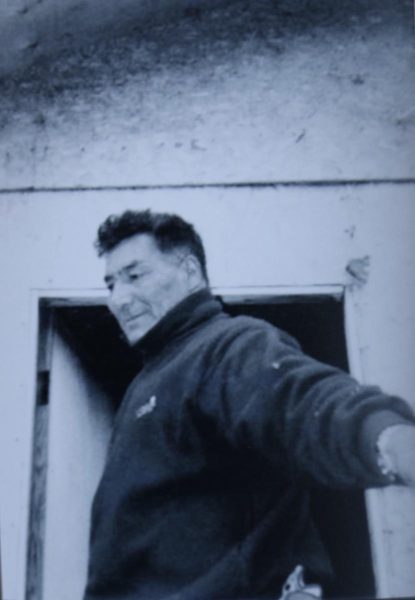
His trapline was located 90 km north of Split lake. The tiny cabin at Trapline 39, which was called Awakekamak, sat near the Churchill River. The incredibly remote location was only accessible by plane in the summer and by snowmobile in the winter. He would attach his handcrafted (but very solid) sled to his 1984 Elan Skidoo and set off on the seven hour snowmobile ride in the -40 degrees Celcius weather. His dog Sparky ran alongside him as he drove off towards the lake. He always took one of his dogs to have as a companion and helper. Of course, he had a warm spot for the dog to rest in the sled for the duration of the travels. We would be sad knowing we wouldn’t see him for a couple months, and looked forward to when he would communicate by radio every once in awhile.
When he came back from the trapline, there was almost always a small family gathering at my grandparents house, especially if there was moose meat cooking on the stove. My grandparents always cooked it the same way. It was sliced into thin pieces, added to a very large cast iron pan with yellow onions, and cooked over medium-low heat for 2-3 hours, or until the meat was super tender. Together the onion and moose meat created its own gravy. Towards the end, salt and pepper was added, and it was always served over mashed potatoes with a piece of fresh baked bannock. Very simple, but so comforting and consistently delicious every time.
We may live in Winnipeg now, but moose meat is still something my family and I are grateful to receive now and then from Split Lake. My uncle Mike took over for my grandpa well before he passed, and is now part of the healthy food program in Split Lake which works towards providing wild meat and fish for community members. I’m so proud that he is passionate about helping to keep Indigenous traditions and way of life alive along with several other men and women from Tataskweyak and surrounding areas.
How does moose meat taste?
The taste of moose meat varies. To some, it tastes more gamey, and to others, it is quite mild like grass-fed beef. The taste depends on the animal and its habitat. It is very very lean. Because of this, we like to braise most cuts (usually roasts) for a longer period of time until tender.
If I don’t have moose meat, what else can I use?
If you don’t have access to moose meat, grass-fed beef, bison, or venison (for a more gamey taste), work well too.
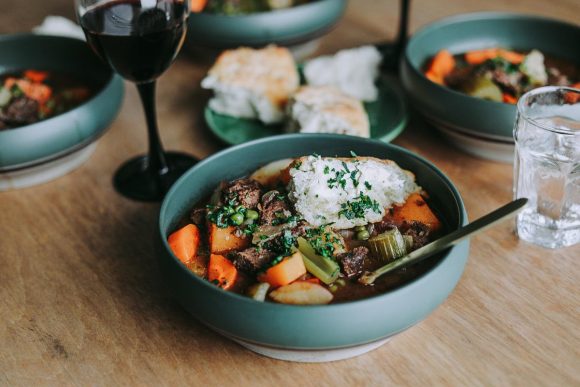
Over the years, I’ve experimented more with different cuts of moose meat in various recipes. Wild mushroom moose burgers, ginger and five-spice moose steak stir fry have been two of my favourites. What I seem to gravitate to most is a rich stew. This recipe for hearty moose stew with winter root vegetables has got to be one of the most comforting dishes, especially in the cold months. Simple whole ingredients, and so much flavour. Braised meat in a flavourful thick broth with earthy root vegetables. I don’t think there is anything better. Well...the only thing that can make it better is enjoying it with a piece of fresh baked bannock.
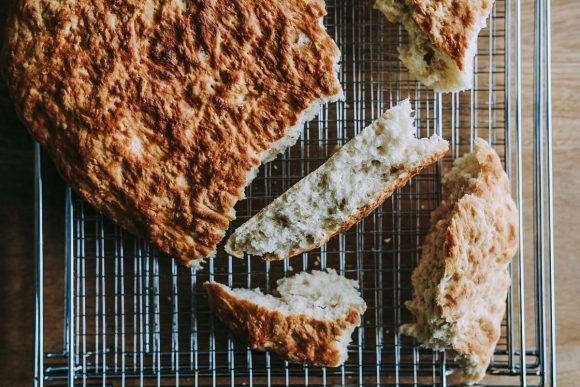
Bannock
If you’re from Manitoba, you probably grew up eating bannock, or have at least tried it. Bannock is a quick flat bread that is very popular amongst Indigenous cultures. It can be baked, fried, made into large rounds, or small individual size portions. Some add molasses and raisins to create a desert-like “brown bannock” which is incredibly delicious, others enjoy it more simply made. My favourite memory is watching my grandparents dip it into tea as their bedtime snack. The thing about bannock is that even though it’s so simple, everyone has their own recipe. For years, my dad has been the bannock maker in our house. He has a simple recipe that consists of flour, shortening, salt, baking powder, and water. It turned out soft and flakey on the inside with a nice golden crust on the outside every time.
The table turned this past year when my Auntie Liz was over and she made her family's recipe. We were very intrigued when the recipe ingredients called for warm milk and egg, and the baking instructions were completely different as well. We watched and waited for the end result, which was was kind of fascinating...and probably the best bannock I have ever tasted in my life. Extra fluffy, airy and light in texture with a crisp bottom and golden top. I’m fairly sure my dad hasn’t used another recipe since then and I’m very happy to be sharing it with you. Unfortunately I haven’t been able to create a gluten-friendly version of this recipe quite yet but hope to master it in the near future.
From the Buck & Garson family to yours, we hope you love these recipes as much as we do. Know that they truly come from a place of pride and close family ties. A place where tradition and culture are alive and well, and most importantly, a place of love. Enjoy these recipes together, or make them separately. Don’t forget to spread a generous amount of jam on any leftover bannock, it is quite heavenly.
Hearty Moose Stew with Winter Vegetables
Ingredients:
• 2 pound moose roast, cut into bite-size cubes (See note)
• 2 tablespoons all-purpose flour or all purpose gluten-free flour
• 3 tablespoons avocado oil or extra-virgin olive oil
• 1 medium sweet onion, cut into chunks
• 6 cloves garlic, pressed
• 3-4 medium size carrots, peeled and chopped into chunks
• 4 ribs celery, ends trimmed and chopped into bite-size pieces
• ½ cup dry red wine
• 5 cups beef broth
• 1/2 tablespoon Worcestershire sauce
• 1 tablespoon tomato paste
• 1 teaspoon dried thyme
• 1 teaspoon dried oregano
• 2 bay leaves
• 2 medium potatoes, peeled and chopped into chunks
• 1 medium rutabaga, peeled and chopped into chunks
• 1 cup green peas
• 3 tablespoons fresh chopped parsley, plus more to serve
• salt and pepper, to taste
Directions
Place the cubed meat in a bowl and season with a generous pinch of salt and pepper. Pat the meat dry with a paper towel, and sprinkle the flour onto the meat and toss together very well, making sure it has been evenly covered. Set aside.
Heat the oil in a large dutch oven or pot over medium-high heat. Once the oil is hot, carefully add the cubed meat, forming a single layer (you might have to do two batches). Do not overcrowd the meat or it will not brown properly. Rotate the cubed moose meat until all sides are browned and crisp on the edges and set aside on a plate.
Lower the heat to medium, and add the onion. Sauté until fragrant and translucent, about 6-7 minutes. Add the garlic, carrots and celery. Stir for an additional 30 seconds, just until garlic is fragrant and softened. Add the red wine, and using a wooden spoon, scrape up any fond (browned bits) that has formed on the bottom of the pot. It is important to do this as it adds an extra depth of flavour to the stew.
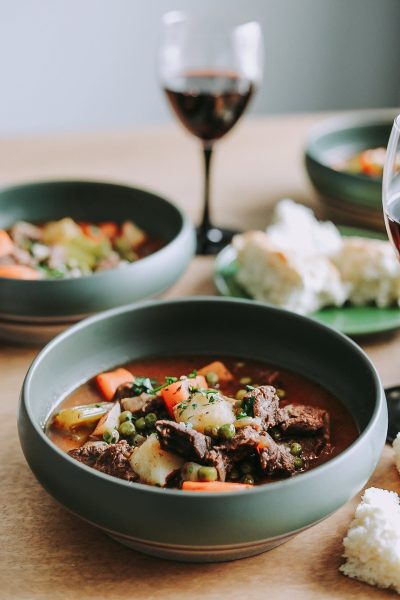
Add the browned meat, beef broth, Worcestershire sauce, tomato paste, herbs, and bay leaves to the dutch oven and bring to a simmer. Once simmering, add the potatoes and rutabaga to the pot, stir very well, and cover. Allow the stew to simmer for 1½-2 hours over low heat, or until the meat is very tender. When the time is up, add the peas and parsley, and simmer for an additional 10-15 minutes.
Season with salt and pepper to taste, and serve with an extra sprinkle of parsley, and fresh bannock.
Note: You can also use stewing beef, bison, or venison
Auntie Liz’s Bannock
Ingredients
• 4 cups all-purpose flour (see note)
• 4 level tablespoons baking powder (Fleischmann’s double-action is highly recommended)
• ¼ teaspoon salt
• 4 tablespoons butter or shortening (I like Nutiva coconut shortening)
• 1 cup water
• 1 cup milk
• 1 egg
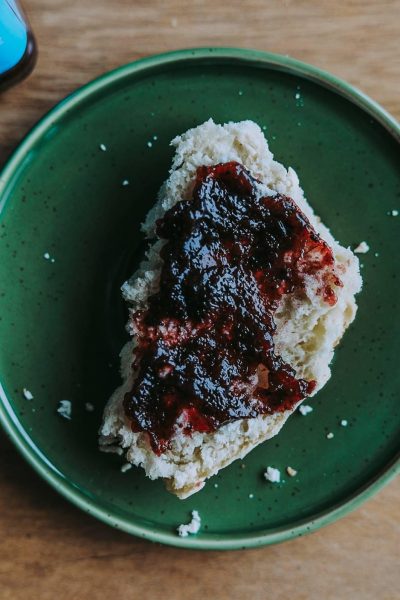
Directions
Preheat the oven to 400℉.
In a large bowl, combine the flour, baking powder, and salt and mix well. Add the butter or shortening. Cut the butter into the flour by rubbing it between your fingers to break it up until no large pieces of butter remain. The end result should look like a crumbly pastry mixture.
In a small pot (or in the microwave) heat the water and milk together just until it is lukewarm in temperature (between 90℉-100℉). Whisk in the egg.
Slowly incorporate the liquid mixture into the flour mixture. Once all the liquid is added, knead together until a dough is formed (add a little flour to your hands if necessary). Cover the dough with a kitchen towel and allow it to rest for 10 minutes.
While the dough is resting, generously grease a large nonstick baking tray with shortening (or coconut oil). Place the pan in the oven for 7-10 minutes.
Carefully remove the pan from the oven, and spread the dough on top of the hot oil. Press the dough down, forming an oval shape that is approximately ¾-inch thick. Using a fork, poke several holes on the top of the bannock.
Bake for 15 minutes, then broil on high for 4-5 minutes until the top is golden brown. Keep an eye on it when it is on broil as it can burn quite fast.
Tear into pieces, and serve hot with butter and moose stew. Store in an airtight container or bag to keep moist.
*Note: this recipe does not work with gluten-free all purpose flour. Many different blends and brands were tested, and it just didn’t turn out the same.
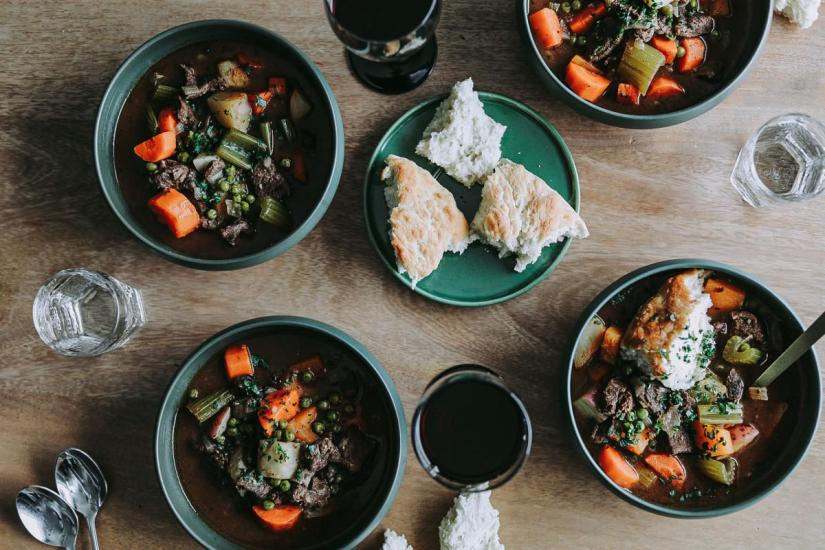

About The Author
Kirsten Buck is a Holistic Nutritionist, recipe developer, and food stylist based in Winnipeg, Canada. Follow along as Kirsten experiments with fresh whole food ingredients on Buck Naked Kitchen.
Holistic Nutritionist
